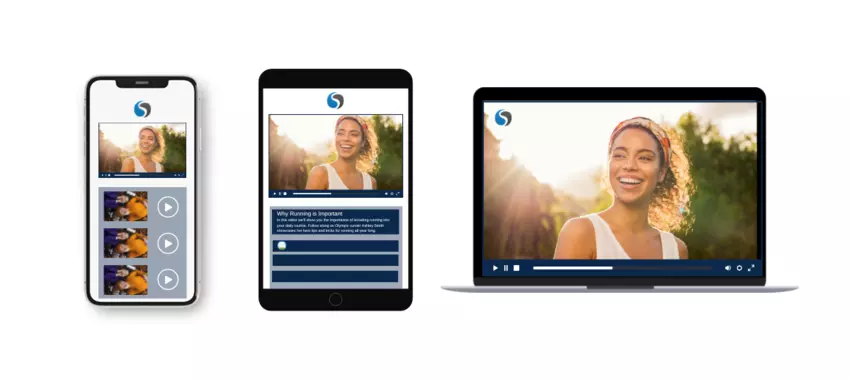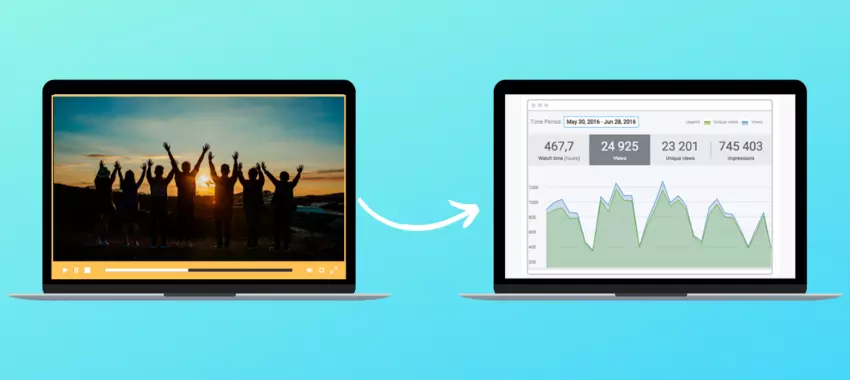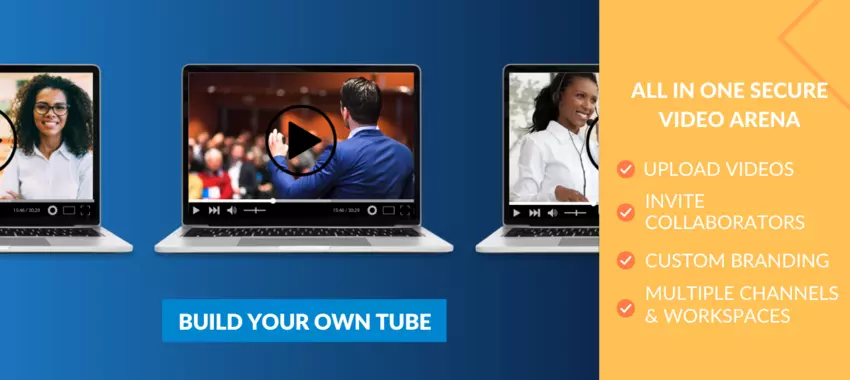
With the popularity of online learning today, video streaming platforms abound. Many online course creators and digital publishers use live streaming and on-demand videos (VOD) to reach audiences. They inevitably experience some problems when it comes to distributing their videos.
Video files are usually large files, and uploading them to a server can significantly slow down a site. If a platform is not designed for managing videos, its size can make things challenging. Some students using online learning platforms may have problems viewing videos depending on the video file type and the device or browser they use.
Using a private video hosting platform can address many of the challenges online course creators experience. E-learning platforms can leverage the power of a private video hosting platform like Cincopa to create and distribute interactive online courses.
The opportunity to leverage their own video tube called CincoTube can give them a great competitive advantage. They can upload video content onto the host’s servers and then embed it on their own site without slowing down their page load times. Other benefits that come with private video hosting for content creators include the protection of their video assets and the use of advanced video analytics to improve online courses.
The benefits of using video in e-learning
E-learning platforms use many videos on their online courses because they can enhance student engagement. Students today expect the kind of visual stimulation that videos provide.
Use live streaming to promote interaction: E-learning platforms today often use live streaming services. They will live stream lectures, and if students miss the live stream, they can go to a link and watch the lecture at a convenient time. Cincopa automatically saves a live stream to a media video library for VOD purposes. Live streams can facilitate storytelling and make corporate communication come alive. Private video hosting companies today have OTT solutions that support live streaming.
Offer unlimited access to VOD: Uploading video lectures to a learning management system (LMS) provides students with unlimited access to video on demand (VOD). Students can learn from anywhere using their mobile devices. They can learn at any time and at their own pace. Customizing their learning can maximize their success. This is why e-learning content providers can’t afford a slow connection or the wrong screen, as this can completely ruin the viewing experience for students.
Explain complex concepts: Videos make it easier to explain complex concepts. The visual component is more engaging than the text alone. Many e-learning businesses use short, animated videos for teaching difficult concepts. They help students to retain more information, and it reinforces what they learn from text documents.
Offer short, interactive content: Most good educational videos come in small modules to accommodate the shorter attention spans of students. If videos are not interactive, students can become bored, so it is important to use interactive elements such as quizzes to make them focus and think.
Embed CincoTube videos in online courses

When online course creators embed CincoTube videos on their sites, they can avoid many problems. They don’t have to upload videos to their own server, so their own website doesn’t slow down. Video hosting spares the site resources, and platforms can make full use of their video assets to powerfully engage their students.
Private video hosting platforms like Cincopa make it easy for e-learning providers to generate embed codes.
Embedding CincoTube videos in online courses is easy. Using iframe embed code allows e-learning enterprises to embed all their videos at once or to embed a single video asset at a time if this is necessary. When you use video embed code on Cincopa, SEO features are automatically included.
They can simply copy and paste the code <iframe width=1000px height=600px src=”URL”></iframe> onto the page of the website where they want to embed their video tube. Where they see “URL,” they need to input the URL of their Tube.
To copy their Tube URL, they must go to the Tube Home Page. There they can copy it from the address bar and insert it. They can also embed a workspace, channel or single video asset in the same way. They simply copy the URL and input it in the iframe code.
Best practices when using videos for online learning

Using Cincopa’s video tube offers many benefits over hosting videos on a platform like YouTube. When using YouTube videos, enterprises can’t brand their videos as their own, and it is far too easy for viewers to copy videos.
Using a video hosting platform makes it possible to brand an online video player and experience more security of video assets. Embedding YouTube videos on a site is easy to do, but they aren’t white-labeled. Anyone can see them, and this isn’t desirable, especially when providing educational content students need to pay to access.
Ensure design is responsive: Private video hosting platforms for businesses like online course providers use various technologies to ensure that students have a great viewing experience. This means e-learning platforms don’t have to worry about storage space, speed optimization, bandwidth or server configuration.
The use of video transcoding enables the recoding of various source footage types into a single video codec or file format. Video encoding compresses RAW video or re-encodes it into a different format. Codec switching happens dynamically when congestion occurs on the network.
Brand the online video player: A private video hosting company like Cincopa offers the opportunity to customize an online video player. Branding the video player with a brand logo, colors, or a watermark means that competitors can’t pass it off as their own.
Optimize videos for search: Online tutoring involves the use of many videos, and it is easy for them to become disorganized and hard for students to find. Centralizing videos in one place and using smart search capabilities is necessary. Enterprises can use metadata and tags to organize videos by topics. Closed captioning and auto-tagging also enhance accessibility.
Secure video assets: It is paramount for online course providers to secure their video assets. Using various layers of security is best. E-learning platforms need to restrict people from using video embed code to embed videos on their own websites.
On the Cincopa platform, it is possible to enable domain restrictions and use various other security measures, such as encryption. Cincopa uses 128-bit AES encryption to secure all communications between viewers and the recording server. A combination of proper network and IT security measures enables users to have end-to-end security.
When online course creators upload videos to the Cincopa platform, they are stored, transcoded and streamed over the web via a global content delivery network (CDN). The CDN allows viewers to access high-quality video that doesn’t buffer or freeze no matter where they view videos. This is because the CDN has widely distributed servers and can serve video content from a server closest to the viewer to ensure quality.
Using CincoTube’s interactive features to enhance online learning experience

It is possible to use various interactive features to enhance videos, such as CTAs, annotations, video chaptering, sub-titles and anchors.
- CTA’s: A call-to-action invites a viewer to take a certain action, such as downloading an ebook, watching another video, signing up for a newsletter, or going to a specific landing page.
- Annotations: You can embed annotations into the timeline so viewers can click on them while they watch a video. Annotations also provide search engines with more information about videos which can help them to rank higher.
- Video chaptering: Dividing a video into chapters provides a way for viewers to see preview thumbnails with a title and description on a timeline. They can go straight to the chapter they want to watch without having to watch a whole video. When they can go straight to the part they want to watch, it can help to reduce the bounce rate.
- Subtitles and closed captions: Subtitles and closed captions show search engines what videos contain so they can rank them. They can also help a video reach a wider audience, such as people who speak other languages or those who are hard of hearing. Viewers can also watch videos on mute and read subtitles if they are in a place like a café or on a bus where they can’t play sound.
- Anchors: Anchors can send viewers to a specific part in a video. This means, as with video chaptering, that they don’t have to watch a complete video. Watching a whole video can be a waste of time when they only need to rewatch a certain part.
- Quizzes: Quizzes enhance interactivity and support student learning. Educators can pick up what students don’t know and design customized learning experiences to fill in any gaps. It is important to keep track of student’s progress to ensure learning is on track.
Measuring and optimizing video performance in e-learning

Private video hosting for businesses, including e-learning businesses, includes the use of advanced analytics. This helps more than the type of analytics offered on free hosting platforms, such as viewer counts, likes or shares. Actionable analytics make measuring and optimizing video performance easier.
Cincopa’s advanced analytics allow e-learning enterprises to see where video views come from, how students interact with videos etc.
Video heatmaps give visual expression to exactly how students engage with videos. E-learning course creators can see where they skip parts, pause, or what parts they tend to rewatch. Knowing where they drop off or which parts of a video engage them most provides valuable information for video enhancement.
Educators can sync student video completion and viewing data with LMS reports to see what kind of impact video is having on progress and grades.
By studying past student data, educators can determine what type of content, assessments and learning paths are most effective for particular students. This means they can create future courses in a way that makes learning more efficient.
To sum it up
CincoTube can help e-learning platforms to stand out in the market by offering them the opportunity to host, manage, search, and distribute video content in the most effective way. Offering e-learning is a business just like any other business, and e-learning institutions must be able to make money to survive and thrive.
Private video hosting offers e-learning platforms many advantages, such as being able to centralize and organize their video assets for easy access. They can use efficient security measures to protect their intellectual property and prevent others from stealing it and using it as their own. It is possible to serve video content that doesn’t freeze or buffer, and students can view them on all devices and using different types of browsers. A big advantage for e-learning platforms is being able to make use of advanced video analytics so they can measure results and optimize video performance.








